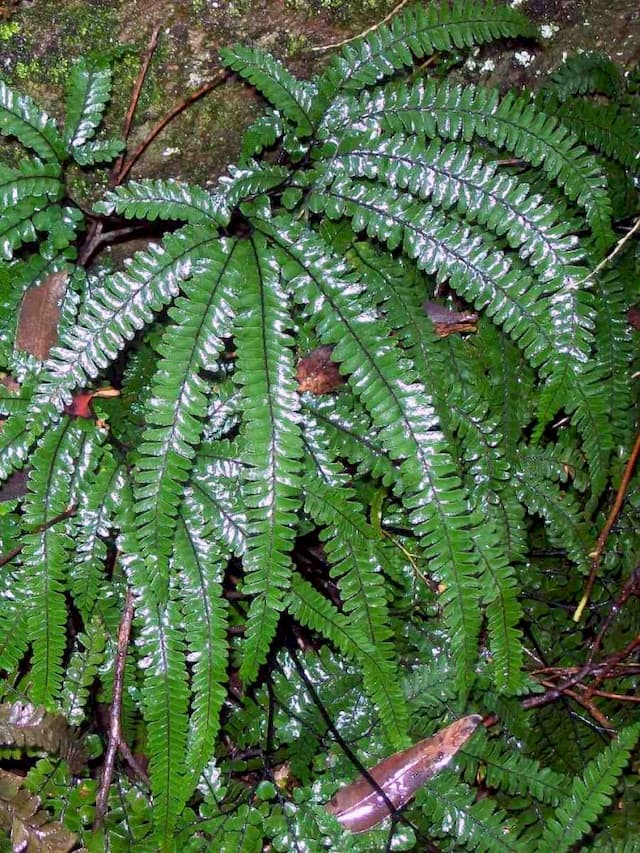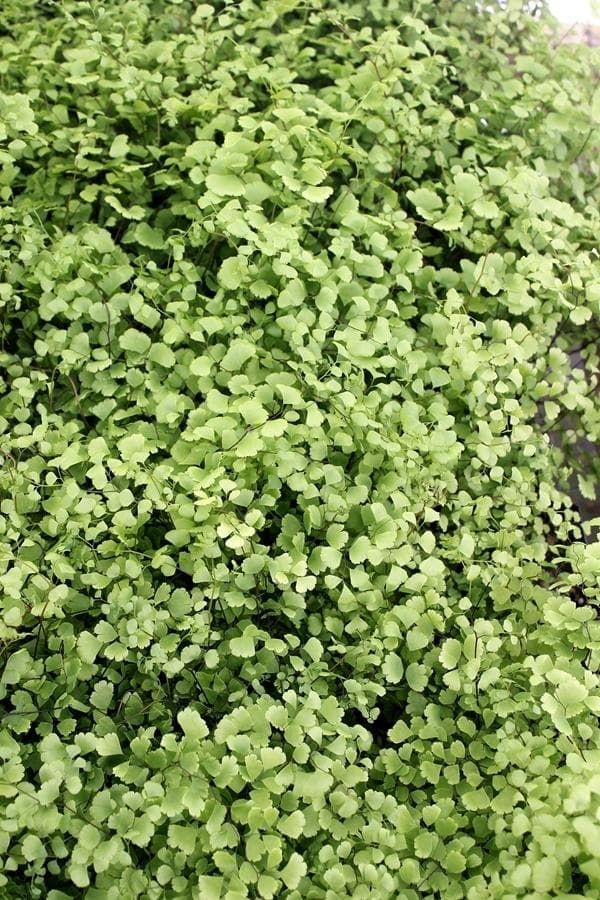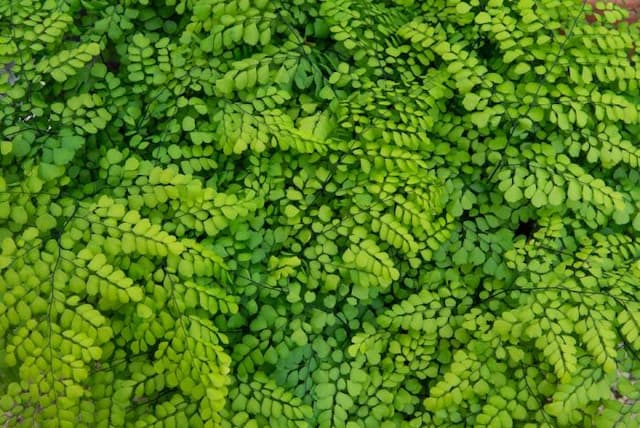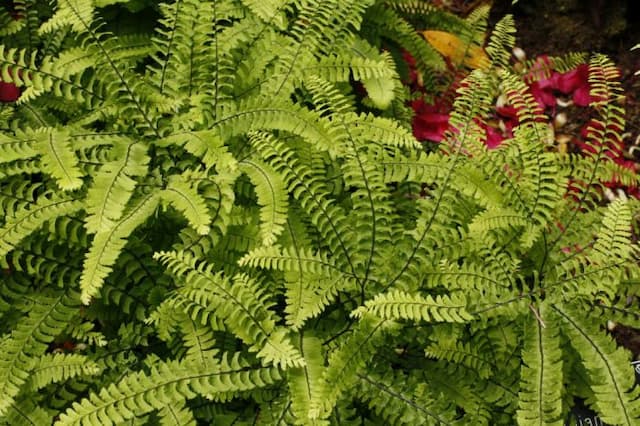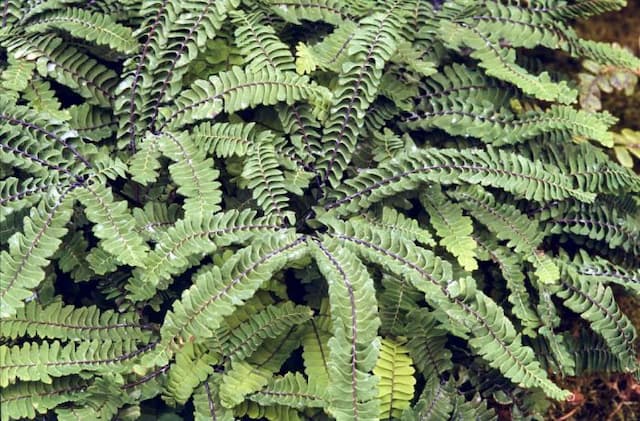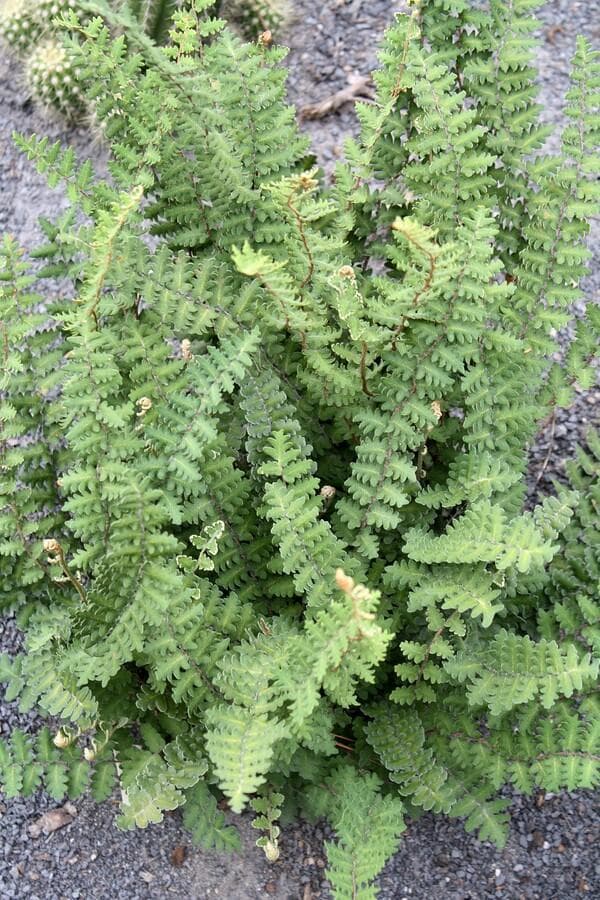Western Maidenhair Fern Adiantum aleuticum 'Imbricatum'

ABOUT
Adiantum aleuticum 'Imbricatum', often known as the western maidenhair fern, is a delicate and graceful plant characterized by its unique foliage structure. The leaves of this fern are notably fan-shaped, resembling a hand with outstretched fingers and are arranged in a fashion that gives a layered or tiled appearance, hinting at the 'Imbricatum' part of its name, which suggests an overlapping pattern. These leaves are supported by thin, wiry stems that have a dark, almost black color, providing a striking contrast against the lush green of the leaves. The plant's overall form is feathery and airy, contributing to its ethereal look. The fern fronds are comprised of numerous small leaflets, each with its own delicate texture and form that adds to the intricate appearance of the plant. The fern has a tendency to spread, forming clusters of green that provide a soft texture to any space they inhabit. It thrives in shady environments, where its verdant leaves can add a fresh, vibrant touch to the understory.
About this plant
 Names
NamesFamily
Pteridaceae.
Synonyms
Western Maidenhair Fern, Aleutian Maidenhair Fern, Imbricated Maidenhair Fern.
Common names
Adiantum pedatum subsp. aleuticum, Adiantum aleuticum.
 Toxicity
ToxicityTo humans
Northern maidenhair fern (Adiantum aleuticum 'Imbricatum') is generally considered non-toxic to humans. There are no significant toxic effects expected from ingesting this plant. It is safe to have in homes and gardens without the concern of human poisoning.
To pets
Northern maidenhair fern is also non-toxic to pets. It does not pose any significant risk of poisoning if pets ingest parts of this plant. Owners can feel confident having this fern in their homes or gardens without worrying about harmful consequences for their pets.
 Characteristics
CharacteristicsLife cycle
Perennials
Foliage type
Deciduous
Color of leaves
Green
Height
1 foot (30 cm)
Spread
1 foot (30 cm)
Plant type
Fern
Hardiness zones
3
Native area
North America
Benefits
 General Benefits
General Benefits- Aesthetic Appeal: Adds a delicate and fine-textured look to gardens with its elegant, fan-shaped fronds.
- Versatility in Landscaping: Ideal for shade gardens, rock gardens, and as an underplanting beneath larger plants.
- Easy to Grow: Tolerates a range of soil types, though prefers moist, well-draining soils and can be easily maintained with minimal care.
- Wildlife Habitat: Provides shelter and breeding grounds for insects and small wildlife within a garden ecosystem.
- Non-Invasive: Unlike some fern species, it typically does not spread aggressively, making it a good choice for controlled landscape designs.
- Cultural Significance: Has historical importance in various cultures and can be used to create a themed garden or to preserve heritage plants.
- Erosion Control: Can help stabilize soil in shady areas where other plants might struggle to take root.
 Medical Properties
Medical Properties- This plant is not used for medical purposes.
 Air-purifying Qualities
Air-purifying QualitiesThis plant is not specifically known for air purifying qualities.
 Other Uses
Other Uses- Art and Crafts: The delicate fronds of Adiantum aleuticum can be used in floral arrangements and dried flower crafts, providing a lacy, intricate texture to the designs.
- Photography Subjects: The distinctive pattern and fine structure of the Adiantum aleuticum's fronds make them excellent subjects for macro and botanical photography.
- Dye Source: The various parts of the plant can be used to create natural dyes for textiles, offering a range of colors from greens to yellows depending on the mordant used.
- Educational Tool: This plant is ideal for teaching about spore reproduction and fern life cycles in biology and botany classes.
- Shade Garden Accent: Adiantum aleuticum adds a touch of elegance to shade gardens, serving as a living decoration where other flowering plants may not thrive.
- Moisture Indicator: Since this fern prefers moist environments, its health can serve as an indicator for adequate moisture levels in terrariums or in the garden.
- Fairy Gardens: Their delicate and miniature look makes them perfect for creating or enhancing fairy gardens and other whimsical garden themes.
- Bonsai Landscaping: Adiantum aleuticum can be used in the landscaping around bonsai trees to add texture and mimic the look of a miniature forest floor.
- Living Walls and Vertical Gardens: They can be incorporated into living wall installations in shady, humid locations, adding a soft, green aesthetic to vertical spaces.
- Backdrop for Aquascaping: The fern can also be used as a background plant in the art of aquascaping, creating a natural backdrop for aquatic plants and animals in aquariums.
Interesting Facts
 Feng Shui
Feng ShuiThe Maidenhair Fern is not used in Feng Shui practice.
 Zodiac Sign Compitability
Zodiac Sign CompitabilityThe Maidenhair Fern is not used in astrology practice.
 Plant Symbolism
Plant Symbolism- Delicate Beauty: Adiantum aleuticum 'Imbricatum', commonly known as Western maidenhair fern, often symbolizes delicate beauty due to its fine and graceful fronds.
- Finely Crafted Artistry: The intricate structure of the fern's leaves can represent a masterpiece of natural artistry, akin to lacework or fine textile.
- Protection and Shelter: In some cultures, ferns are believed to provide protection and shelter, as they create a canopy in the understory of forests.
- Secret Bond of Love: The Western maidenhair fern is sometimes associated with secret love or a bond that is both tender and strong, possibly due to its hidden sori (spore cases) that resemble secret messages tucked away beneath its leaves.
- Eternal Youth: The lush green color and perennial nature of ferns lend to their association with youthfulness and the ability to withstand the test of time.
- Purity and Sincerity: Ferns like the Western maidenhair are often thought to symbolize purity and sincerity, echoing the unblemished and honest aesthetics of their foliage.
 Water
WaterThe Western Maidenhair Fern should be watered regularly to maintain evenly moist but not soggy soil. Typically, this means watering it once or twice a week, depending on the humidity and temperature conditions of the environment. It is important to use lukewarm water and gently water the soil, rather than the fronds, to provide approximately 16 to 24 ounces of water each time. During the winter months, reduce watering but never allow the soil to completely dry out.
 Light
LightThe Western Maidenhair Fern thrives in bright, indirect light away from direct sunlight. A north-facing window or a spot that receives filtered light through a sheer curtain would be ideal. This plant does well in the dappled light of a shaded garden if kept as an outdoor specimen, but should always be protected from harsh, direct sun which can scorch its delicate fronds.
 Temperature
TemperatureThe optimal temperature range for the Western Maidenhair Fern is between 60 to 75 degrees Fahrenheit, with a minimum temperature tolerance down to about 50 degrees Fahrenheit. Avoid sudden temperature drops and cold drafts, as well as excessively hot environments. Ensuring stable temperature conditions will contribute to the health and growth of the fern.
 Pruning
PruningThe Western Maidenhair Fern benefits from occasional pruning to remove dead or damaged fronds, which promotes healthy growth and improves air circulation. Prune sparingly, only as needed, and best done in the spring. Use clean, sharp scissors to cut the fronds at the base, closest to the soil.
 Cleaning
CleaningAs needed
 Soil
SoilThe Western Maidenhair Fern requires a well-draining, rich organic soil mix with a pH ranging from 6.0 to 7.5. A blend of peat, perlite, and pine bark works well.
 Repotting
RepottingThe Western Maidenhair Fern should be repotted every 2 to 3 years or when it becomes root-bound.
 Humidity & Misting
Humidity & MistingWestern Maidenhair Fern thrives in high humidity conditions, ideally between 60% to 80%.
 Suitable locations
Suitable locationsIndoor
Place in bright, indirect light and maintain high humidity.
Outdoor
Shield from direct sun; moist, well-draining soil; high humidity.
Hardiness zone
3-8 USDA
 Life cycle
Life cycleThe life cycle of the Western maidenhair fern (Adiantum aleuticum 'Imbricatum') begins with the germination of spores released from reproductive structures on the undersides of mature fronds. Upon finding a suitable moist environment, spores develop into a small, heart-shaped gametophyte called a prothallus, which houses both male and female reproductive organs. Fertilization occurs when sperm swims to an egg in the presence of water, leading to the growth of a sporophyte, which is the recognizable fern plant. This young fern, or fiddlehead, unravels and grows into a mature fern with fronds that photosynthesize to support the plant. As the fern matures, it produces new spores on the underside of its fronds, continuing its lifecycle. The Western maidenhair fern persists through the seasons, year after year, capable of living for many years and reproducing multiple times throughout its life.
 Propogation
PropogationPropogation time
Spring-Early Summer
The Western maidenhair fern, or Adiantum aleuticum 'Imbricatum,' is best propagated by dividing the rhizomes in the spring. To do this, carefully dig up the plant, ensuring a good amount of roots and fronds are attached to each section of rhizome. Using a sharp, sterilized knife or pair of garden shears, cut the rhizome into sections, each with at least one growing point, which appears as a bud or frond starting to unfurl. Replant the divisions at the same soil depth as the original plant, and water generously to help establish the roots. Provide a humid environment and maintain consistent moisture without waterlogging the soil, as ferns do not tolerate dry conditions well.

